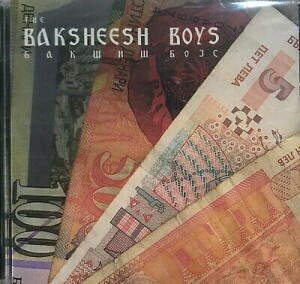 Judith Gennett wrote this review.
Judith Gennett wrote this review.
At my college, the typical folkdancer was a nerdy professor’s daughter wearing a homemade polyester peasant blouse who danced with a buck-toothed smile to crackly Monitor LPs. Hence, I long ago missed the boat on Eastern European music. Now, they’ve got wonderful live party music on that boat and I have two left feet! Maybe listening to some of that music saves others from the fate of being left on shore with my feet.
One of the fun domestic party bands is currently known as the Baksheesh Boys and they have just released a CD. Formerly known as the Fetatonics, The Boys are a weekend Balkan dance band based in Los Angeles and The Bay Area. Their self-titled album of jangly, semi-acoustic dance music from Macedonia is their first, but hopefully not their last!
The band’s members include two members of the Bay Area’s nuevo-Balkan band the Toids, Bill Lanphier on bass and percussionist Jerry Summers; two members of the Celtic-Pan-European band StinkEye, Linda Koidara on fiddle and Pat MacSwyney on tambura and kaval; and indie band Pseudopod bassist Brian Fox on guida, tambura, and other frets.
Percussion and the bouzouki-like tambura are the most noticeably heard instrumental sounds in these often uneven rhythmed dance songs, which is why the songs are so light and jangly! But you might also catch a measure where gaida or the kaval flute are featured. Otherwise most of the instruments serve nicely but fairly homogenously as traditional dance fuel. On the low and defiant end, Lanphier’s bass is understated, but always carries a definite jazzy rock spirit of a modern dance party! Unlike their Seattle Balkanic comrades, Baksheesh’s electric bass and guitar never really push any boundaries.
Best of all are Angela Rodel’s village style vocals, found on most of the tracks, effortless and pretty, but pretty powerful as well. Rodel, a UCLA graduate student and former director of the UCLA Bulgarian Women’s Choir, will probably be heard for music rather than lyrics since most of us don’t understand Bulgarian or Macedonian (if you look in the liner notes, though, you will find that most of the songs are predictably about shepherds, romance, and rakia.) The band could be compared to an Irish traditional band with a wonderful female vocalist and both traditional and modern instruments … particularly bouzouki and bodhran! My comparison would be with Triona Ni Dhomnaill, or for that matter Marta Sebestyen.
The music itself, however, is far different than Irish music, at least on the surface, thanks to the meter and the Ottoman modes. Rodel’s showpiece is the only Bulgarian track on the album, a very slow song called “Lale Li Si.” Augmented by kaval, her haunting ornamented vocals are like a quiet dark stream. Three shepherds come bearing gifts to a womens’ work party. Oddly, the lyrics are not so sad as the sinuous delivery would imply! The other sets are all at least partly Macedonian. A long meandering 9/8 “Chuperlika/Kalino, Kalinche” is very Greek-like, and then breaks into measures that seem to me more typically Macedonian. Others are “just” nice dance songs. “Ostana Radika/Milo Mi E Magde” is a gaida rich 9/8 dajchovo tune about a woman who has become a widow at seventeen. “Vasilke Malka Nevesto/Bre Vodenicharyu” is another perky 9/8 set, with one love song about a too-fancy neighborhood, another about a miller. “Chuli Sa, Male/Tri Bilibilja Poev” is in 7/8, and also contains a bit of gaida. The first half is relaxing, the second is not! “Tvoj Ochi, Leno Mori/Oldu Mu Ya” in 2/4 time ends with a Turkish instrumental song and is a good place to hear the bass; perhaps this is the most adventuresome selection! The oddest song is the last, a “hoedownsako oro” called “Sofke More Sofke.” “Sofka’s parents refuse to let her marry Georgi. Upon learning that they have gone to church to curse them, Georgi curses them in return, asking that the church fall on them, kill her mother and strike her father dumb so that they can’t object to the marriage.” Well …
There are times I wish that there were a little more geographic variety and sometimes I wish that the music were a little rockier. Taking out the “western instruments” and dehomogenizing the arrangements might make a few of the tunes starker and more interesting. But these are points of style. The musicians are good, the arrangements are good, the singer is good, and the music is great for dancing!
(self-released, 2003)
